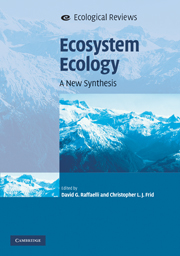Book contents
- Frontmatter
- Contents
- List of contributors
- Preface
- 1 The evolution of ecosystem ecology
- 2 Linking population, community and ecosystem ecology within mainstream ecology
- 3 Thermodynamic approaches to ecosystem behaviour: fundamental principles with case studies from forest succession and management
- 4 Ecosystem health
- 5 Interdisciplinarity in ecosystems research: developing social robustness in environmental science
- 6 The links between biodiversity, ecosystem services and human well-being
- 7 Ecosystem ecology and environmental management
- Index
- References
1 - The evolution of ecosystem ecology
Published online by Cambridge University Press: 05 June 2012
- Frontmatter
- Contents
- List of contributors
- Preface
- 1 The evolution of ecosystem ecology
- 2 Linking population, community and ecosystem ecology within mainstream ecology
- 3 Thermodynamic approaches to ecosystem behaviour: fundamental principles with case studies from forest succession and management
- 4 Ecosystem health
- 5 Interdisciplinarity in ecosystems research: developing social robustness in environmental science
- 6 The links between biodiversity, ecosystem services and human well-being
- 7 Ecosystem ecology and environmental management
- Index
- References
Summary
Introduction
The sustainable use, management and conservation of ecosystems, as promoted by the Convention on Biological Diversity's Ecosystem Approach (United Nations 1992), and recent initiatives such as the Millennium Ecosystem Assessment (United Nations 2005), emphasise the inter-dependence between ecological systems and human well-being. Healthy social systems demand healthy ecosystems and vice versa. This emergent world view is compelling and persuasive to conservationists, policy makers and managers alike, because it implies win-win solutions for nature conservation and for human development which relies on the continued provision of ecosystem goods and services. Ecosystem management within this context requires a holistic approach that acknowledges the need to work with and across a broad range of natural, physical, social and economic sciences. Whilst there are many successful programmes which have achieved this, mainstream ecologists who have so much to bring to the table have been slow to embrace such approaches. Jones and Paramor (this volume) consider many of the important cultural challenges. The view that humans are part of, not apart from, the biophysical system in which they are embedded has not always sat comfortably with academic researchers, who have traditionally seen their prime focus on, and responsibility to, either the natural system or to broader societal goals, but rarely both. In addition, there are misunderstandings and fears about what holistic ecosystem approaches really are, in turn due to the divergent pathways along which different sections of the ecological community have developed.
- Type
- Chapter
- Information
- Ecosystem EcologyA New Synthesis, pp. 1 - 18Publisher: Cambridge University PressPrint publication year: 2010
References
- 3
- Cited by



